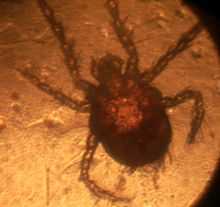Trombicula autumnalis
| Trombicula autumnalis | |
|---|---|
 | |
| Scientific classification | |
| Kingdom: | Animalia |
| Phylum: | Arthropoda |
| Class: | Arachnida |
| Subclass: | Acari |
| Order: | Trombidiformes |
| Family: | Trombiculidae |
| Genus: | Trombicula |
| Subgenus: | Neotrombicula |
| Species: | T. autumnalis |
| Binomial name | |
| Trombicula autumnalis (Shaw, 1790) | |
| Synonyms | |
|
Neotrombicula autumnalis[1] | |
The harvest mite, Trombicula autumnalis, is a species of mite of the family Trombiculidae. Their larvae live parasitically; they infect all domestic mammals, humans, and some ground-nesting birds.[2]
Description
The larvae are normally orange or red in color with only six legs, but develop eight legs by nymph stage. The larvae are only up to 0.2 millimetres (0.008 in) in size.[2] The adult mites are about 1 mm (0.04 in) long.[2]
Life cycle
The eggs are laid in damp soil. After hatching, the larvae climb blades of grass and wait for a potential host.[2]
With their "blade-like chelicerae",[2] they attach themselves to the host and feed on its tissues. After sucking, which lasts several days,[2] they fall off and develop over three stages of nymph to adult mites.
References
- ↑ http://www.vetstream.com/lapis/Content/Bug/bug00357
- ↑ 2.0 2.1 2.2 2.3 2.4 2.5 Richard Wall & David Shearer (2001). "Trombiculidae". Veterinary Ectoparasites: Biology, Pathology, and Control (2nd ed.). John Wiley and Sons. pp. 47–48. ISBN 978-0-632-05618-7.